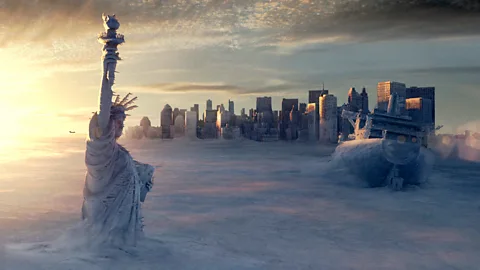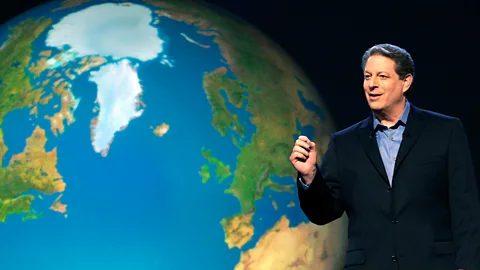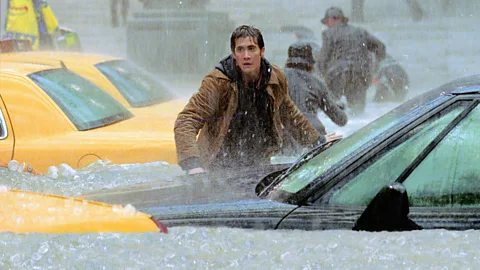Why does cinema ignore climate change?
 Alamy
AlamyApocalyptic films feature disease, war or alien invasions – but there’s one thing they almost always avoid. Nicholas Barber asks why Hollywood is still so squeamish about the real environmental crisis.
Whether you believe that art imitates life or life imitates art, it often seems as if the 21st Century is imitating a Hollywood blockbuster. At the moment, as many of us have observed, the current situation seems to be echoing Contagion and 28 Days Later. Before that, the climate crisis – with its news reports about hurricanes, tidal waves and wildfires – felt like every mega-budget movie about a world-shaking apocalypse.
The strange thing is, though, that despite the uneasy connection between environmental news reports and apocalyptic films, climate change is mentioned in hardly any of them. On the big screen, the threats to civilisation as we know it are war (The Book of Eli; Mad Max: Fury Road; Alita: Battle Angel), disease (Zombieland; World War Z; Contagion; Inferno), drugs that were intended to counteract disease (I Am Legend; Rise of the Planet of the Apes), alien invasions (Oblivion; Edge of Tomorrow; A Quiet Place), and demons (This Is The End). Clearly, this glut of doom-laden entertainment was responding to our anxieties about the state of the planet. But the idea that our carbon footprints might have something to do with it doesn’t get a look-in.
More like this:
In The Core (2003), the Earth’s core has stopped rotating, and nuclear explosions are required to jump start it. In Danny Boyle’s Sunshine (2007), it’s the Sun which is almost defunct, and again, nuclear explosions are what’s needed to bring it back to life. In Christopher Nolan’s Interstellar (2014), the problem is crop blights. In Alfonso Cuarón’s Children of Men (2006), it’s infertility. Then there is Bong Joon-ho’s Snowpiercer (2013), which the Korean director made a few years before the Oscar-winning Parasite. His dystopian action movie is set during a new ice age, but rather than being brought about by climate change per se, the catastrophe was caused by a misguided attempt to reverse it by “dispersing CW7 into the upper levels of the atmosphere”.
 Alamy
AlamyThe only major Hollywood feature film to have the opposite message is Roland Emmerich’s The Day After Tomorrow (2004). The German writer-director is best known for Independence Day and Godzilla, both of which gloried in mass destruction, but his interest in extreme weather conditions and ecological issues was evident decades earlier. The student film he made in 1984, The Noah’s Ark Principle (Das Arche Noah Prinzip), was set aboard a space station that could whip up torrential storms. In 1990, he released another science-fiction thriller, Moon 44, in which corporations were mining for minerals all across the galaxy, having used up the Earth’s natural resources. Then, once he was established in Hollywood, Emmerich used Art Bell and Whitley Strieber’s book, The Coming Global Superstorm, as the basis of his star-studded, 1970s-style disaster movie.
Like his other films, The Day After Tomorrow is about as stupid and clichéd as cinema gets. But parts of it hold up remarkably well. The panic-buying scenes are all too prescient (although no one appears to be stockpiling toilet paper), and the satire has sharpened with age. When the US become largely uninhabitable, refugees pile south across the Rio Grande, but are not allowed into Mexico until all Latin American debt is cancelled. This conceit was bold enough in 2004, but today, in the ‘Build the Wall’ era, it seems revolutionary.
Hollywood’s bad habits
More importantly, at least as far as Hollywood was concerned, The Day After Tomorrow was a box-office smash. The sixth highest grossing release of 2004 – just one place behind The Passion of the Christ – it proved that a film could have prominent environmental themes and still rake in several hundred million dollars. And yet it didn’t set a trend for climate-conscious eco-thrillers. The subject cropped up in documentaries, such as the Oscar-winning adaptation of Al Gore’s slide show, An Inconvenient Truth (2006). But directors of fictional films continued to shy away from climate change, and even Emmerich retreated from it. When he made another global disaster move, 2012 (2009), he blamed the worldwide floods in the film on... errr... neutrinos from a solar flare, as opposed to anything that human beings might have done.
 Alamy
AlamyPerhaps the structure of The Day After Tomorrow can offer some clues as to why it is such a one-off. The film starts well, with a climate researcher, Professor Jack Hall (Dennis Quaid), nearly plummeting to his doom in the Antarctic when a mile-long crack splits the ice shelf beneath his feet. Soon afterwards, he explains how the North Atlantic Current works to the US’s sceptical vice president (Kenneth Welsh, a Dick Cheney lookalike), but Emmerich doesn’t keep things theoretical for long. Hailstones the size of tennis balls batter Tokyo. Tornadoes rip Los Angeles to pieces. Helicopters fall from the sky when their fuel lines freeze in Scotland. A frighteningly convincing tsunami sloshes through Manhattan, submerging its streets and turning its skyscrapers into islands. New York is then buried under metres of snow and ice. The science may be iffy, but these scenes are vivid enough to make anyone think twice about ordering a gas-guzzling new car.
Once you’ve shown civilisation being flattened, though, where do you go next? Much of the film’s second half is given over to Jack’s teenage son Sam (Jake Gyllenhaal) trying to stave off frostbite in The New York Public Library, while Jack hikes through the snow to find him. These scenes are fine, but they can’t help but seem insignificant compared to the devastation we’ve just witnessed. Ultimately, who cares about Jack and Sam? Blockbuster movies tend to be about the heroes’ efforts to save thousands or millions of lives. They concoct a cure for a virus or they disarm a bomb. In Emmerich’s own canon, they topple a humungous mutant lizard (Godzilla) and they blow up a squadron of alien spacecraft (Independence Day). In contrast, all Jack does is reunite with his son; society at large is still in tatters.
 Alamy
AlamyCould that be why climate change is so often overlooked by filmmakers? Because it’s just too big and overwhelming for a two-hour adventure? And because it can’t be fixed by a hero defeating a villain? In a way, almost every one of us is the villain of the story, due to our own small daily choices to take that flight, to eat that steak, and to upgrade that phone. It’s understandable that Hollywood studios don’t want to alienate audiences by reminding them of that inconvenient truth. Commercially speaking, it’s more sensible to blame the apocalypse instead on some mad scientist’s experiments or some foreign dictator’s nuclear missiles.
It’s also true that Hollywood can’t complain about our environmental unfriendliness without drawing attention to its own. The average film is a paean to conspicuous consumption: an invitation to covet private jets, luxurious apartments, and designer outfits. And The Day After Tomorrow itself has its share of product placement. Behind the scenes, the industry isn’t much better. It relies on countless people flying all over the world, first to make a film and then to promote it in the most opulent possible fashion. In January, Stella McCartney boasted on Twitter that Joaquin Phoenix would be doing his bit for “the future of the planet” by wearing one dinner suit “for the entire award season”, ie, a couple of months. The tweet was roundly mocked, especially by those of us who have worn the same dinner suit for 20 years.
 Alamy
AlamyStill, the statement was at least a sign that Hollywood is aware of its own bad habits. Other signs include the Producers Guild of America’s new Green Production Guide, and Sony’s move to install solar panels on its soundstages. But will James Bond ever swap his Aston Martin for a bicycle? Will Phoenix wear his Stella McCartney suit next award season? And, when the film business gets up and running again, will Hollywood start greenlighting some more disaster movies which face the climate crisis head on, as The Day After Tomorrow did?
Love film and TV? Join BBC Culture Film and TV Club on Facebook, a community for cinephiles all over the world.
And if you liked this story, sign up for the weekly bbc.com features newsletter, called The Essential List. A handpicked selection of stories from BBC Future, Culture, Worklife and Travel, delivered to your inbox every Friday.
